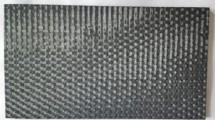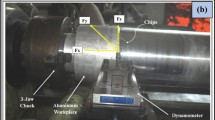Abstract
Silicon carbide fiber-reinforced silicon carbide matrix composites have attracted attention due to superior properties, such as low density, high strength, and high-temperature resistance. However, it often faces severe tool wear during cutting, with the fibers and matrix material being of high hardness and brittleness, which has an inevitable effect on the engineering application of this kind of material. In this paper, wear volume VW is used to evaluate the tool wear through solid modeling and parameter measurement based on the tool wear topography in turning of SiCf/SiC ceramic matrix composites. Conventional turning (CT), ultrasonic vibration-assisted turning (UVAT), and ultrasonic vibration-assisted turning with water cooling (W-UVAT) experiments are carried out using CBN, PCD, and PDC tools to investigate and analyze the cutting performance. In the meantime, the tool wear mechanism and form are studied based on the analysis of ultrasonic vibration on tool wear, the geometric position of wear, accumulation of cutting workpiece powders, and tool wear curve. Experimental results found that the PDC tool obtains the best cutting performance, which is more suitable for turning silicon carbide fiber-reinforced silicon carbide matrix composites. Within the experimental parameters, with the increased ultrasonic amplitude A, VW decreases first and then increases, reaching a minimum at A which is 3 µm. The main wear mechanism of the PDC tool is abrasive wear, and the primary wear form is the spalling of polycrystalline diamond abrasive grains.




























Similar content being viewed by others
Data availability
All authors confirm that the data supporting the findings of this study are available within the article.
Code availability
Not applicable.
References
Paulmier T, Balat-Pichelin M, Queau DL (2005) Structural modifications of carbon–carbon composites under high temperature and ion irradiation[J]. Appl Surf Sci 243(1–4):376–393
Ohnabe H, Masaki S, Onozuka M, Kaoru M, Tadashi S (1999) Potential application of ceramic matrix composites to aero-engine components[J]. Compos A Appl Sci 30(4):489–496
Wang PR, Liu FQ, Wang H, Li H, Gou YZ (2019) A review of third generation SiC fibers and SiCf/SiC composites[J]. J Mater Sci Technol 35(12):2743–2750
Wu DF, Wang YW, Shang L, Pu Y, Gao ZT (2016) Thermo-mechanical properties of C/SiC composite structure under extremely high temperature environment up to 1500° C[J]. Compos B Eng 90:424–431
Kumar J (2013) Ultrasonic machining—a comprehensive review[J]. Mach Sci Technol 17(3):325–379
Diaz OG, Luna GG, Liao Z, Axinte D (2019) The new challenges of machining ceramic matrix composites (CMCs): review of surface integrity[J]. Int J Mach Tool Manu 139:24–36
Sonia P, Jain JK, Saxena KK (2021) Influence of ultrasonic vibration assistance in manufacturing processes: a review[J]. Mater Manuf Process 36(13):1451–1475
An QL, Chen J, Ming WW, Chen M (2021) Machining of SiC ceramic matrix composites: a review[J]. Chinese J Aeronaut 34(4):540–567
Cao JG, Wu YB, Lu D, Fujimoto M, Nomura M (2014) Fundamental machining characteristics of ultrasonic assisted internal grinding of SiC ceramics[J]. Mater Manuf Process 29(5):557–563
Prasad BS, Babu MP (2017) Correlation between vibration amplitude and tool wear in turning: numerical and experimental analysis[J]. Eng Sci Technol 20(1):197–211
Shen JY, Wang JQ, Jiang B, Xu XP (2015) Study on wear of diamond wheel in ultrasonic vibration-assisted grinding ceramic[J]. Wear 332:788–793
Palanikumar K, Davim JP (2007) Mathematical model to predict tool wear on the machining of glass fibre reinforced plastic composites[J]. Mater Design 28(7):2008–2014
Das D, Chakraborty V (2018) Dry condition machining performance of T6 treated aluminium matrix composites[J]. Mater Today: Proc 5(9):20145–20151
Airao J, Nirala CK, Lacalle LNL, Khanna N (2021) Tool wear analysis during ultrasonic assisted turning of nimonic-90 under dry and wet conditions[J]. Metals 11(8):1253
Feng YX, Hsu FC, Lu YT, Lin CT, Lin CF, Lu YC, Liang SY (2020) Tool wear rate prediction in ultrasonic vibration-assisted milling[J]. Mach Sci Technol 24(5):758–780
Liu HZ, Zong WJ (2019) Prediction model of tool wear volume in precision turning of ceramic particle reinforced aluminum matrix composites[J]. Int J Adv Manuf Technol 100(9):2689–2700
Ma LJ, Sun ZC, Zhang L, Deng H, Tan YQ, Kong Z, Wei ZQ (2020) Study on mechanism and theoretical model of tool wear in fluorophlogopite glass-ceramics turning[J]. J Mater Process Technol 275:116284
Zhao H, Zhou M (2008) An experimental study on diamond cutting of optical glass[C]//Key Engineering Materials. Trans Tech Publications Ltd 375:211–215
Sarma DK, Dixit US (2007) A comparison of dry and air-cooled turning of grey cast iron with mixed oxide ceramic tool[J]. J Mater Process Technol 190(1–3):160–172
Dai CW, Yin Z, Wang P, Miao Q, Chen JJ (2021) Analysis on ground surface in ultrasonic face grinding of silicon carbide (SiC) ceramic with minor vibration amplitude[J]. Ceram Int 47(15):21959–21968
Rajasekaran T, Palanikumar K, Vinayagam BK (2012) Turning CFRP composites with ceramic tool for surface roughness analysis[J]. Procedia Eng 38:2922–2929
Shan CW, Wang X, Yang XX, Lyu XB (2016) Prediction of cutting forces in ball-end milling of 25 D C/C composites[J]. Chinese J Aeronaut 29(3):824–830
Babbar A, Sharma A, Jain V, Jain AK (2019) Rotary ultrasonic milling of C/SiC composites fabricated using chemical vapor infiltration and needling technique[J]. Mater Res Express 6(8):085607
Zhang B, Du YN, Liu HL, Xin LJ, Yang YF, Liang Li (2021) Experimental study on high-speed milling of SiCf/SiC composites with PCD and CVD diamond tools[J]. Materials 14(13):3470
Dhokey NB, Utpat K, Gosavi A, Dhoka P (2013) Hot-press sintering temperature response of diamond cutting tools and its correlation with wear mechanism[J]. Int J Refract Met Hard Mater 36:289–293
Kılıckap E, Cakır O, Aksoy M, İnan A (2005) Study of tool wear and surface roughness in machining of homogenised SiC-p reinforced aluminium metal matrix composite[J]. J Mater Process Technol 164:862–867
Bhushan RK (2020) Impact of nose radius and machining parameters on surface roughness, tool wear and tool life during turning of AA7075/SiC composites for green manufacturing[J]. Mech Adv Mater Mod Process 6(1):1–18
Wu X, Li L, He N, Zhao GL, Jiang F, Shen JY (2018) Study on the tool wear and its effect of PCD tool in micro milling of tungsten carbide[J]. Int J Refract Met Hard Mater 77:61–67
Li X, Seah WKH (2001) Tool wear acceleration in relation to workpiece reinforcement percentage in cutting of metal matrix composites[J]. Wear 247(2):161–171
Quan YM, Zhou ZH (2000) Tool wear and its mechanism for cutting SiC particle-reinforced aluminium matrix composites[J]. J Mater Process Technol 100(1–3):194–199
Zeng WM, Li ZC, Pei ZJ, Treadwell (2005) Experimental observation of tool wear in rotary ultrasonic machining of advanced ceramics[J]. Int J Mach Tool Manu 45(12–13):1468–1473
Liu Y, Liu ZB, Wang XB, Huang T (2020) Experimental study on tool wear in ultrasonic vibration–assisted milling of C/SiC composites[J]. Int J Adv Manuf Technol 107(1):425–436
Wang H, Hu YB, Cong WL, Hu ZL (2019) A mechanistic model on feeding-directional cutting force in surface grinding of CFRP composites using rotary ultrasonic machining with horizontal ultrasonic vibration[J]. Int J Mech Sci 155:450–460
Wang JJ, Feng PF, Zhang JF, Guo P (2018) Reducing cutting force in rotary ultrasonic drilling of ceramic matrix composites with longitudinal-torsional coupled vibration[J]. Manuf Lett 18:1–5
Wang JJ, Zhang JF, Feng PF, Guo P, Zhang QL (2018) Feasibility study of longitudinal–torsional-coupled rotary ultrasonic machining of brittle material[J]. J Manuf Sci Eng 140(5):051008
Tool-Life Testing with Single-Point Turning Tools (1993) International standards, ISO 3685–1993(E). International Organization for Standardization, Geneva
Ning F, Cong W (2020) Ultrasonic vibration-assisted (UV-A) manufacturing processes: State of the art and future perspectives[J]. J Manuf Process 51:174–190
Peng ZL, Zhang XY, Zhang DY (2021) Effect of radial high-speed ultrasonic vibration cutting on machining performance during finish turning of hardened steel[J]. Ultrasonics 111:106340
Júnior MG, França TV, Fortulan CA, Silva RHLD, Foschini CR (2022) Green ceramic machining benefits through ultrasonic-assisted turning: an experimental investigation[J]. Int J Adv Manuf Technol 118(9):3091–3104
Xiong YF, Wang W, Jiang R, Liu C (2022) Feasibility and tool performance of ultrasonic vibration-assisted milling-grinding SiCf/SiC ceramic matrix composite[J]. J Mater Res Technol 19:3018–3033
Acknowledgements
Thanks to Dr. Xiaoxiang Zhu and Dr. Zhanfei Zhang for their help on the logic and thinking of this paper. Many thanks to the ultrasonic vibration equipment supported by Xi’an Chao Ke Neng Ultrasonic Technology Research Institute Co., Ltd.
Funding
This work is sponsored by Special Fund Project for Independent Technology Innovation of Aero Engine Corporation of China (Grant No. ZZCX-2019–022).
Author information
Authors and Affiliations
Contributions
Cong Liu: the guidance and planning of the overall thinking, optimized and guided the experimental process, performed data measurement and analysis, wrote the first draft, and revised the contents of the first draft.
Wenhu Wang: provided financial support for materials and equipment, supervision, and reviewing the first draft.
Yifeng Xiong: responsible for the planning of the overall thinking and logic and revised and reviewed the first draft.
Bo Huang: assisted in conducting experiments and revised and reviewed the first draft.
Liangwan Li: assisted in conducting experiments, performed data measurement, and revised the draft.
Corresponding author
Ethics declarations
Ethics approval
The manuscript has not been submitted to any other journal for simultaneous consideration. The submitted work is original and has not been published elsewhere in any form or language.
Consent to participate
All authors voluntarily agree to participate in this research study.
Consent for publication
All authors voluntarily agree to publish in this research study.
Conflict of interest
The authors declare no competing interests.
Additional information
Publisher's Note
Springer Nature remains neutral with regard to jurisdictional claims in published maps and institutional affiliations.
Rights and permissions
Springer Nature or its licensor (e.g. a society or other partner) holds exclusive rights to this article under a publishing agreement with the author(s) or other rightsholder(s); author self-archiving of the accepted manuscript version of this article is solely governed by the terms of such publishing agreement and applicable law.
About this article
Cite this article
Liu, C., Wang, W., Xiong, Y. et al. Experimental investigation on tool wear in ultrasonic vibration-assisted turning of SiCf/SiC ceramic matrix composite. Int J Adv Manuf Technol 125, 3081–3101 (2023). https://doi.org/10.1007/s00170-023-10896-2
Received:
Accepted:
Published:
Issue Date:
DOI: https://doi.org/10.1007/s00170-023-10896-2




